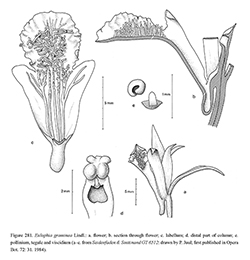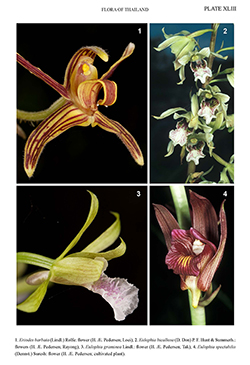e-Flora of Thailand
Volume 12 > Part 2 > Year 2014 > Page 511 > Orchidaceae > Eulophia
7. Eulophia graminea Lindl.wfo-0000959912
Gen. Sp. Orchid. Pl.: 182. 1833; Hook.f., Fl. Brit. India 6: 2, 196. 1890; Seidenf. & Smitinand, Orchids Thail.: 483, 816, fig. 357, t. XX(1253). 1961–1965; Seidenf., Opera Bot. 72: 29, fig. 14, t. Id. 1984; Opera Bot. 114: 327. 1992; Seidenf. & J.J.Wood, Orchids Penins. Malays. Singap.: 539, fig. 244f–g. 1992; S.Thomas, Lindleyana 13: 181. 1998; J.B.Comber, Orchids Sumatra: 213 (incl. colour photo). 2001; N.Pearce & P.J.Cribb, Fl. Bhutan 3(3): 249, fig. 58. 2002; Nanakorn & Watthana, QSBG (Thai Native Orchids 2): 88, colour photos on pp. 88–89. 2008; S.C.Chen et al. in Z. Wu et al. (eds), Fl. China 25: 255. 2009; Sitthisajjadham & Tripetch, Wild Orchids Thail. 2: 257, colour photos on pp. 256–257. 2009; Barretto et al., Wild Orchids Hong Kong: 337, fig. 280–283. 2011. Fig. 281; Plate XLIII: 3.
Accepted Name : This is currently accepted.
Synonyms & Citations :
Description : Plant with pseudobulbs above ground (or partly buried). Pseudobulbs (conical-)ovoid to oblongoid, 3–8.5 cm long, 2–4.6 cm in diameter. Foliage leaves 4–5, present at anthesis, leaf bases forming a 1–5 cm long pseudostem; free part of each leaf narrowly linear to linear lanceolate, acuminate, 11–46 by 0.3–1 cm. Inflorescence racemose or paniculate, 39–79 cm tall, lax, 12- to many-flowered; peduncle green, 16–41 cm long; floral bracts shorter than ovaries. Flowers spreading, opening widely, mainly (brownish-)green (labellum white with mostly purplish-red ornaments). Sepals acuminate, often mucronate; dorsal sepal linear-oblanceolate, 10.5–14.3 by 2–3 mm; lateral sepals linear-oblanceolate, slightly oblique to slightly falcate, 11.2–15.5 by 2.2–2.8 mm. Petals obliquely lanceolate, acuminate, 9.6–10.9 by 2.6–3.3 mm, glabrous. Labellum 3-lobed, 10.4–13.5 by 7–8.4 mm when flattened, widest across side lobes, spurred at base, glabrous on the ventral side; mid-lobe broadly elliptic to obovate, rounded to obtuse, often apiculate or mucronate, margins undulate; ornaments of 3–5 prominent, often branched keels extending from the labellum base to the mid-lobe where they produce numerous long tubercles; spur subclavate, slightly incurved, 3.1–3.5 mm long. Column 4.7–5 mm long; column foot much shorter than column proper, not forming a spur. Ovary (including pedicel) 11.2–21 mm long. Capsule pendent, ellipsoid, 1.6–3.1 cm long (excluding pedicel and perianth remnants), 0.7–1.2 cm in diameter.
Thailand : NORTHERN: Chiang Mai, Chiang Rai, Phrae (Ban Mae Phuak), Tak, Phitsanulok (Thung Salaeng Luang); NORTH-EASTERN: Phetchabun (Nam Nao), Sakon Nakhon (Ban Kut Na Kham), Mukdahan; EASTERN: Chaiyaphum (Phak Pang), Si Sa Ket (Ban Chia), Ubon Ratchathani (Khong Chiam); SOUTH-WESTERN: Kanchanaburi, Prachuap Khiri Khan; CENTRAL: Saraburi, Krung Thep Maha Nakhon (Bangkok); SOUTH-EASTERN: Prachin Buri (Ban Tha Chang), Chon Buri, Rayong (Ko Samet), Chanthaburi; PENINSULAR: Chumphon (Tako), Ranong (Kapoe), Surat Thani, Phangnga, Krabi (Ko Chum), Nakhon Si Thammarat, Trang (Ko Libong), Songkhla, Yala (Betong), Narathiwat (Tak Bai).
Distribution : Sri Lanka, Pakistan, India, Nepal, Bhutan, Bangladesh, Myanmar, S China, Indochina, Ryukyus, Taiwan, Peninsular Malaysia, Singapore (type), Sumatra, Java, Borneo, the Philippines, Guam; additionally some presumably anthropochorous occurrences in East Timor, Australia, S Africa and Florida.
Ecology : Coastal heath forests, lower tropical rain forests, seasonal evergreen forests, deciduous forests, scrub, crevices of limestone cliffs, open sandy soil along freshwater swamps and river banks, ruderal ground, clearings, roadsides and as a weed on arable ground; 0–750 m alt. Flowering all year round, but mainly December–April.
Vernacular : Wan bua ka (ว่านบัวแก้ว)(Prachin Buri); hua khao tom (หัวข้าวต้ม)(Bangkok); hua khao yen (หัวข้าวเย็น)(Phrae); a-bae-ba-kung อาแบบากุง, ba-wae-ba-kong (บาแวบากง)(Malay-Narathiwat).
Notes: Experiments in Florida have shown that Eulophia graminea is self-compatible (although with reduced fecundity in self-pollinated flowers), but they have also shown that self-pollination does not occur spontaneously (Pemberton et al., 2008). The pollinator fauna is unknown, but suitable pollinators (probably minor bees) seem to be available throughout the very wide specific range (O’Byrne, 2011b). Efficient vegetative propagation, an ultra-fast life cycle and a flexible flowering pattern add to the ability of E. graminea to colonize disturbed ground and compete successfully in the first phases of (re)colonization (O’Byrne, 2011b).
As could be expected, many occurrences of Eulophia graminea are found at disturbed sites (for example, the species has been observed repeatedly in the immediate surroundings of the Forest Herbarium in Bangkok!) and it is one of the few orchid species that seem to be increasing in frequency in Thailand these years. This pattern is the same throughout the natural distribution range, and during the last few decades, E. graminea has also expanded beyond its traditionally known range – appearing in Java, East Timor, Australia (Northern Territories, Queensland), South Africa and Florida (e.g. Pemberton et al., 2008). In some of these regions, the species has even become naturalized. O’Byrne (2011b) surveyed and evaluated deliberate and accidental means by which human dispersal of E. graminea may occur within and beyond the natural range of the species.
I have seen no herbarium specimen of this species from Phetchabun; the above record is based on Tokaew & Chantaranothai (2009).


